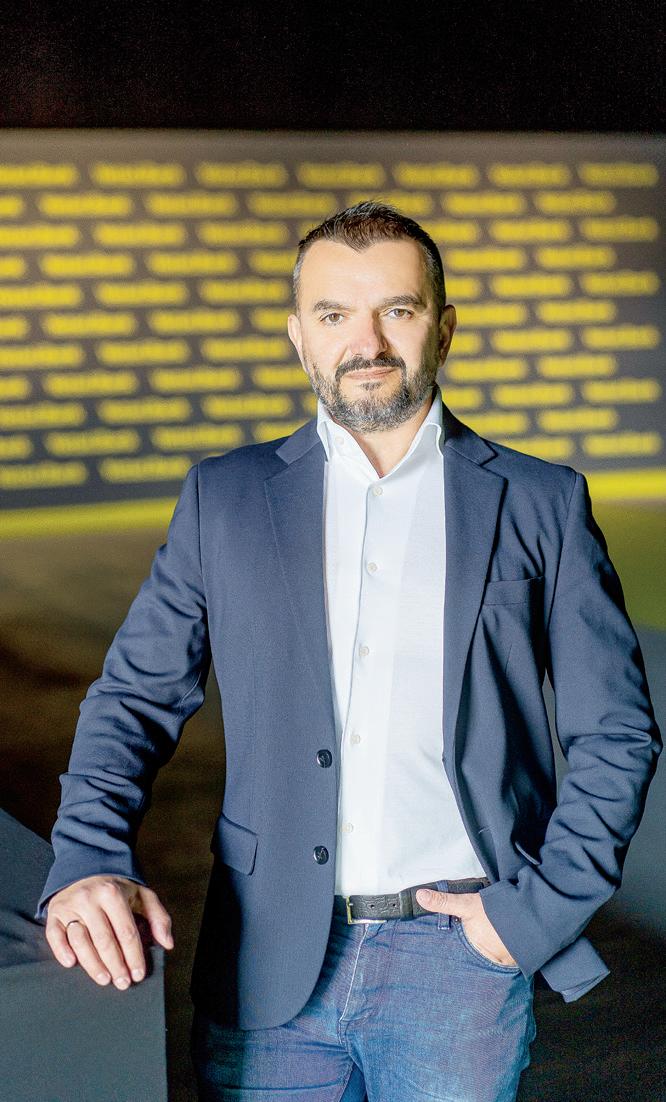






Jorgovanka Tabaković Governor of the National Bank of Serbia

Aleksandar Bogdanović President of Executive Committee of Yettel Bank
Rade Rakočević CEO and Founder of Senzal Capital Belgrade
Zoran Blagojević Chairman of the Executive Board of Wiener Städtische Insurance
Twenty Years of the Credit Bureau of the Association of Serbian Banks
EDITOR IN CHIEF Neda Lukić n.lukic@aim.rs
DESIGN
Slađan Radosavljević Zoran Perović design@aim.rs
PHOTOS Zoran Petrović
COPY EDITOR Mark Pullen
PROJECT MANAGERS Biljana Dević b.devic@aim.rs Mihailo Čučković m.cuckovic@aim.rs Nataša Novković n.novkovic@aim.rs
OFFICE MANAGER Svetlana Petrović s.petrovic@aim.rs
FINANCE Dragana Skrobonja finance@aim.rs CEO Ana Novčić a.novcic@cordmagazine.com
PUBLISHER Ivan Novčić i.novcic@aim.rs
Rotografika d.o.o. Segedinski put 72, Subotica FINANCIAL SECTOR 2024
Published by: alliance international media Prote Mateje 52, 11111 Belgrade 17, PAK 125806, Serbia Phone: +(381 11) 2450 508
office@aim.rs; office@cordmagazine.com www.aim.rs; www.cordmagazine.com
2560-4465
2023

By prioritising digitalisation, Serbia’s financial sector can remain agile and responsive in a rapidly evolving market landscape, positioning itself for continued success in the digital age
Serbia’s steady growth prospects indicate a resilient economy with opportunities for investment and innovation. Additionally, falling inflation rates suggest a controlled economic environment that’s conducive to sustainable growth. For the financial services industry, this translates into a stable operating environment, encouraging confidence among investors and consumers alike. As Serbia continues to position itself as an attractive destination for business and investment, the financial sector is poised to play a pivotal role in driving economic development and prosperity.
Banks have historically been the go-to source for companies seeking financing, as they offer a range of products and services to support business growth. In Serbia’s banking sector, a small number of banks dominate the market. However, while larger banks hold sway, smaller institutions, like the new Yettel Bank, are carving out their own niche, indicating a potential shift in strategy for highly specialised players offering tailored services to specific sectors. By focusing on specialised servic-

es, these banks can distinguish themselves from larger competitors and attract clients seeking personalised solutions. Moving forward, this diversification of the banking sector could lead to increased competition and innovation, ultimately benefiting consumers with a wider range of options and tailored services.
Serbia’s banking and insurance sectors are digitalising rapidly, boosting efficiency, modernising services and enhancing client satisfaction. This shift also spurs innovation from start-ups offering cutting-edge solutions and services in these industries. Moreover, these changes receive support from expert services that are crucial for fulfilling legal requirements in delicate and complex financial operations.

AS CONSUMERS INCREASINGLY TURN TO DIGITAL CHANNELS FOR THEIR BANKING AND INSURANCE NEEDS, MARKET PLAYERS ARE COMPELLED TO ADAPT AND INNOVATE IN ORDER TO REMAIN COMPETITIVE
In the future, it will be essential to actively showcase the investment opportunities available to Serbian citizens, including shares, ETFs, alternative funds, cryptocurrencies, gold, and crowdfunding. By diversifying sources of capital, Serbia’s economy can become more resilient and adaptable to changing market dynamics. Moreover, increased competition in the financing space could lead to improved terms and conditions for borrowers, ultimately benefiting all stakeholders in the economy.
The improving of the country’s external position as a result of a stronger export performance and higher net FDI inflows, as well as the maintaining of a stable fiscal position, will bring us closer to obtaining an upgraded credit rating

ational Bank of Serbia
NGovernor Jorgovanka Tabaković stated recently that the Serbian economy’s resilience in the face of global shocks has once again been put to the test and confirmed. This relates primarily to easing inflation, steady economic growth and good export results. However, growth figures remain far from sufficient to place Serbia on a trajectory ensur-
ing the country’s faster convergence with the EU.
What are the key challenges preventing Serbia from achieving this kind of growth?
— According to our May projection, economic growth will stand at around 3.5% this year, while we project growth ranging from four to five per cent in the coming years. According to international finan-
cial institutions, this year Serbia’s economic growth will be among the highest in the region of Central and Southeast Europe. Those responsible for Serbia’s economic policy are striving to secure a sustainable economic growth rate over the long term that doesn’t cause a problem in terms of external and fiscal imbalances and doesn’t lead to rising inflation, and that is only possible in the way Serbia’s
economic policy is currently being conducted. In the period prior to the 2008 global economic crisis, Serbia’s economic growth averaged six per cent annually, but this was unsustainable because it was based on expenditure, while investments and net exports had a contribution that was either negligible or negative. Achieving a GDP growth rate of seven per cent at this juncture would imply significantly faster growth of personal and government spending, which isn’t sustainable in the long term because it would result in rising inflation and an increasing fiscal deficit and public and external debt, as well as a poorer credit rating and sources of financing being more expensive and less available. Instead of this,
the end of this April. Given the fact that we were exposed to the biggest shocks in recent history over the past three years and that rising inflation was largely driven by global cost-push pressures, but also that we managed to maintain our country’s overall macroeconomic stability even under the circumstances of the greatest global uncertainty following the outbreak of the energy crisis and the conflict in Ukraine, reducing inflation to levels close to the target range can be considered a success. It should be noted in particular that we succeeded in preserving the relative stability of the foreign currency exchange rate, and the anchoring of medium-term inflation expectations, throughout the entire period of the global cri-
WE WEREN’T ABLE TO PREVENT INFLATION GROWTH FROM OCCURRING, BUT WE CERTAINLY LIMITED THAT GROWTH SIGNIFICANTLY AND ENSURED ITS DOWNWARD TRAJECTORY
we’ve decided to accelerate economic growth and increase production capacities gradually, while simultaneously ensuring a favourable growth structure.
According to your forecasts, inflation could enter the target tolerance band of 3 to 4.5 per cent as early as this month (May). However, looking back at the total increase in the cost of living over the previous period, could it really be said that Serbia’s struggle against inflation was successful?
— According to our projections, inflation is most likely to return to within the target range this month, after which it will continue to slow and will, as of next year, fluctuate around the midpoint of three per cent. Inflation has maintained a strong downward trajectory since April last year and fell by 11.2 percentage points to five per cent by
— The key factor contributing to high FDI inflows, which reached a record level of 4.5 billion euros last year, is certainly the maintaining of macroeconomic stability even during periods of the biggest challenges at the global level, while relative exchange rate stability and a healthy and stable financial sector were ensured by the favourable macroeconomic prospects of our economy, an important part of which is price stability over the medium term. Additional factors of importance for FDI inflows include structural improvements to the competitiveness of our economy, a good strategic position and close proximity to the European Union, which is still the source of the majority of investments, as well as the fact that Serbia has the largest economy in the Western Balkan region. As is often emphasised by foreign investors, it is no less important that Serbia has a high-quality and highly qualified workforce and that it has signed FTAs with the European Union, CEFTA countries, Turkey, Russia and, as of recently, China.

We’ve decided to accelerate economic growth and increase production capacities gradually, while simultaneously ensuring a favourable growth structure
ses that emerged one after another, while in recent months we’ve also recorded an accelerated decline in the short-term expectations of the financial and business sectors. We weren’t able to prevent inflation growth from occurring, but we certainly limited that growth significantly and ensured its downward trajectory, while simultaneously minimising the negative impact of tightening monetary conditions on economic growth and financial stability. Moreover, we have ensured the preservation of the real value of citizens’ wages and living standards as a result of the curbing of inflation and the growth of nominal income under conditions of positive economic growth expectations.
When it comes to FDI inflows, what are the key growth triggers today?
You recently assessed Serbia as being halfway towards the historic goal of receiving an upgraded credit rating. What represents the other half of this journey?
— We take great care in analysing every recommendation of ratings agencies in areas requiring further improvement, which we address responsibly and systematically. Ratings agencies are essentially seeking that we merely continue applying sound and sustainable economic policies. It is precisely due to the fact that countries were confronted by multiple crises over the previous four years that credit rating agencies are currently taking into consideration the ways economic policymakers reacted under such circumstances. The strengthening of Serbia’s economic position during the aforementioned period, as well as the resilience against shocks from the international environment demonstrated by our economy, provide us with reason for op-
An important factor for FDI inflows are the FTAs that Serbia has signed with the EU, CEFTA countries, Turkey, Russia and, as of recently, China
We have secured record foreign currency reserves exceeding 25 billion euros, which cover over 300% of the debt due for repayment within a one-year period, so we have no reason to worry about our external debt
timism that Serbia could receive an investment grade in the near future. Factors potentially leading to an upgraded credit rating include an improved external position of the country under the conditions of a stronger export performance and higher net FDI inflows, as well as maintaining an orderly fiscal position. One of the recommendations that’s under the jurisdiction of the NBS relates to the need to make further progress in the area of dinarisation. With an awareness that this is a long-term process, we are working with a commitment to en-
THE NBS PROVIDES STRONG SUPPORT, IN THE POLITICAL FORMAT OF THE TALKS, TO FINDING A SOLUTION AND ENSURING THE USE OF THE DINAR IN OUR SOUTHERN PROVINCE
suring the future continuation of the positive trend of dinarisation, which has undoubtedly been present since 2012.
Despite investments being generally high, there have essentially been no changes in the former main investment sectors, such as the banking and insurance sectors, except if we exclude the departure of foreign banks and the reinforcement of the positions of domestic ones. How would you explain this?
— Thanks to decisive and essential reforms, as well as intensive regulatory activities, we have established a suitable operational framework for banks and insurance companies, as well as a favourable environment for the arrival and operations of credible and creditworthy investors. The changes of ownership and status that led to the consolidation of the domestic banking sector in the previous period were depend-
ent on the individual decisions and business policies of shareholders, who were guided by the legislating of a competitive market and their own business interests, as well as the NBS’s assessment of the economic justification of those status changes and their impact on the state of the financial market. From our perspective, it is crucial that bank owners be committed to effectively supervising their own operations, regardless of whether they are under foreign or domestic ownership. This is achieved by ensuring the professional management of banks that focus on both business results and stable growth in the value and quality of the assets those banks manage, but that focus above all on the interests of the clients that they live from. The same principles also apply to the insurance sector.
We are recording good current account deficit coverage, very good export results and the growth of foreign currency reserves. Is that sufficient for us to consider it unnecessary to worry about the growth of debt in general, and particularly towards large creditors such as China?
— When it comes to the indebtedness of the state, the economy or individuals, it is important to bear in mind what these funds will be used for, the debt repayment deadline, the borrowing conditions and currency, and primarily whether it will be able to be utilised to service our obligations. Our economy’s external debt possesses all of these desirable aspects, as supported by the declining trajectory of that debt, the good currency compatibility of the government debt with the currency structure of foreign reserves and the predominant debt of the economy in euros, in which export revenues are also generated. When it comes to the debt to China, it accounts for approximately 10% of our total foreign debt, and the lion’s share of that debt belongs to the government, which relates entirely
to loans for projects in the fields of transport, energy and utility infrastructure. The infrastructure that it provides will contribute to building our production and export capacities, and thus also to generating income that we will be able to utilise to service our existing debt repayment obligations.
What is your stance with regard to the position of the dinar in Kosovo and possible outcomes?
— Our position has remained unchanged from the outset. We most strongly condemn the illegal measures taken by the Provisional Institutions of Self-Government in Kosovo and Metohija, which prohibit the use of dinars in our southern province. These measures were adopted hastily, covertly, under the pretext of various quasi-monetary and quasi-financial excuses, and without any legal and legitimate basis. These measures don’t only contravene elementary international finance and banking standards, as well as agreements made to date and the way dinar cash flows have been unfolding for years, but are rather directly intended to deny the basic income earned in dinars by the population and businesses in Kosovo and Metohija. The institutions of the Republic of Serbia are exerting huge efforts to ensure an effective solution to the problem that has arisen. And in discussions to date, under extremely difficult circumstances, they have demonstrated exceptional constructiveness and willingness to reach an agreement and solve the problem, which has unfortunately been lacking on the Priština side so far. The NBS provides strong support – in the political format of the discussions and within the dialogue at the existing level – to providing an effective solution, without delay, to the problem caused by the adoption of these discriminatory, illegal and unprecedented measures, and to providing protection to the Serbian people in Kosovo and Metohija.
I am proud to lead our customers into a new era of secure digital banking by the end of this year, with the introduction of second-generation video identification: Liveness
President of Executive Committee of Yettel Bank
s we move forward with launching the new Yettel Bank application, we have taken the first step towards creating a bank that prioritises your needs and preferences. As we advance along this path, we have placed the utmost importance on enhancing security measures, because safeguarding your data is our top priority. We have implemented the latest technologies and established stringent protocols to ensure that your data remains safe and protected at all times.
ATechnologies like facial recognition and fingerprint identification were once rare, while they are today popular features integrated into numerous applications, including the new Yettel Bank app. However, our drive to provide customers with uncompromising security has led us to seek solutions that set new standards in data protection. I am thrilled to announce that, by the end of the year, we will propel our customers into a new era of secure digital banking by introducing second-generation video identification: Liveness.
Liveness is a state-of-the-art biometric solution that’s applied widely across the EU as a mechanism for identity verification at border crossings and by fi -
nancial and other institutions offering personalised services. It represents video identification with individual characteristics that are almost impossible to copy or misuse. This advanced mechanism uses the device’s camera to thoroughly analyse facial characteristics and expressions, thus confirming the customer’s physical presence. Instead of biometric templates that smart devices store and use for facial recognition, Liveness identifies the actual person in real time and space with near 100% reliability.
INTRODUCING SUCH FUNCTIONALITIES IS PART OF OUR VISION FOR MODERN, SECURE BANKING. HOWEVER, ALL EFFORTS WOULD BE IN VAIN WITHOUT THE SUPPORT AND EXAMPLES PROVIDED BY THE NATIONAL BANK OF SERBIA

This technology uses 3D face detection to eliminate all attempts at impersonation. This means that false objects, photographs, or video recordings cannot be used to create or access online accounts. In addition to increasing customer security and preventing potential data misuse, Liveness is also an excellent tool for enhancing the customer experience. It is well known that people dislike having to remember passwords and security questions, queue for verification, or fill out lengthy requests. By using second-generation video identification, we arrive at a simple solution to this problem, whilst also saving time and increasing data security in the online world.
Trust is crucial in digital banking, and we are committed to earning and maintaining it. Our proactive security strategy involves anticipating and preventing potential threats and continuously educating users on various aspects of online security to ensure the highest level of safety. Introducing such functionalities is part of our vision for modern, secure banking, and we are grateful for the support and examples set by the National Bank of Serbia. The NBS’s commitment to creating a stimulating regulatory environment, and to continuous innovation in the banking market, inspires our further development.
TWENTY YEARS OF THE CREDIT BUREAU OF THE ASSOCIATION OF SERBIAN BANKS
The servers of the ASB Credit Bureau generate reports in just two seconds, making it the world’s fastest credit bureau
The Credit Bureau of the Association of Serbian Banks, which is now celebrating its 20th anniversary, has not only marked a significant milestone, but has also revolutionised banking practices. Over the course of the two decades of its existence, it has delivered nearly 10 million credit history reports without a single major security incident.
Reflecting on the past, it’s hard to fathom the era before the establishment of the Credit Bureau. Prior to 2004, banks struggled to maintain independent records of their clients’ creditworthiness, leading to lengthy approval processes and higher interest rates for diligent payers. The lack of valid credit history data posed a significant risk to banks.
The heart of the Credit Bureau now resides in the Zelendata [Greendata] Centre in Vršac, Serbia’s pioneering ecological data centre. This state-of-the-art facility houses data for as many as 5.2 million citizens and nearly half a million registered businesses and entrepreneurs, using servers that are physically small, yet extremely powerful. The innovative immersion cooling technology submerges the servers deep in mineral oil, creating an efficient cooling system. This results in annual energy savings of up to 800,000 euros compared to other cooling systems, while extending the lifespan and enhancing the performance of these invaluable devices.
In an era of heightened concern over citizens’ data, the Credit Bureau employs one of the most advanced and secure methods. Each bank has a private space on the server that it uses to store clients’ data. These data do not belong to other banks or the Credit Bureau itself, and it

is only with the formal consent of the account holder that the Credit Bureau app can access specific data and make them available to the bank or the client in the form of a report.
High security requirements do not negatively impact the speed of operations. Indeed, on the contrary, the Credit Bureau generates a requested report within two seconds and, considering the communication time between the bank and the Credit Bureau, a total of approximately five seconds is required for the report to be delivered. This makes the Credit Bureau of the Association of Serbian Banks the world’s fastest credit bureau.
Such systems are targets of cyberattacks worldwide, and our Credit Bureau is no exception. The fact that all such attacks so far have been repelled speaks volumes about how the Bureau’s security is protected.
However, cybersecurity success to date cannot be taken for granted. The
Financial CERT (Computer Emergency Response Team) – which also operates under the auspices of the Association of Serbian Banks – is continuously engaged in enhancing the security of the banking system and the financial sector as a whole.
CERT experts work in multiple directions with various interested groups. One of these efforts is a continuous campaign to educate citizens. Through traditional and new media, clients are informed about new cyber risks and given helpful advice on avoiding dangers.
CERT connects with all relevant authorities, institutions, and experts in the country and around the region. Permanent cooperation has been established with the Special Prosecutor’s Office for High-Tech Crime in the exchange of data in the field of cybersecurity. Training sessions have been organised with leading experts on cryptocurrencies and potential fraud, while a meeting has also been held with the Montenegrin Cyber Incident Response Team in order to exchange experiences and achievements.
The development of the Credit Bureau of the Association of Serbian Banks has benefited everyone. Banks can enter into credit transactions with reduced risk and can more easily introduce new services. Clients can quickly meet their financing needs and benefit from their clean banking history. A diligent client is now clearly distinguished from one that fails to fulfil their obligations on time.
It is for all these reasons that the Association of Serbian Banks has every reason to be proud of the achievements of the Credit Bureau, which will continue to enhance the quality of its services.


CEO and Founder of Senzal Capital Belgrade
As a developing country, we need increased competition and a better quality and more innovative offer in the banking and financial sector
We’ve seen a reduction in the number of banks operating in Serbia in recent years, with large banks having taken over smaller ones. There are 20 banks currently operating in Serbia,
which is nine fewer than a decade ago. The wave of consolidations and bank takeovers is also expected to continue next year. We are simultaneously also witnessing the departure of foreign banks and the strengthening of domestic ones.
Here we discuss these and other Serbian financial market trends with Senzal Capital Founder and CEO Rade Rakočević.
What do these banking market trends tell you?
— The five largest banks in Serbia have a market share exceeding 60%, and it is only a matter of how many days we will have to wait to see some new banking sector takeover. Potential buyers have a clear motive, as they can achieve more positive effects with an increased number of clients and higher deposits and credit potential.
However, my view is that this isn’t a positive trend and that talk of Serbia needing even fewer banks only benefits the big banks, which are becoming even bigger, while we – as a developing country, according to the IMF – need increased competition and a better quality and more innovative offer in the banking sector.
I think it would be beneficial for Serbia to have more specialised banks doing business with specific groups of clients from specific fields of business, such as entrepreneurs, start-ups and the agricultural sector, which could tailor their offers to companies and individuals from that sector and should be subjected to more liberal conditions for their establishment.
It also isn’t clear to me why Serbia doesn’t have microcredit organisations that should ensure speed and simplicity when it comes to investing in and financing SMEs and citizens.
We only have a few investment and pension funds in Serbia. Is this due to the lack of a culture of investment or something else? If, as you’ve said, one serious German city has more funds than the whole of Serbia, what prevents our country from having a larger and more diverse offer? — I like to describe the Serbian financial market as a big puddle with only a few crocodiles.
I founded the Senzal brokerage house back in the year 2000 with capital of just €5,000. Today’s threshold for establishing a brokerage house is €125,000. If that threshold had applied back then, you would now be conducting this interview with someone else.
The number of licensed pension and investment fund management companies in Serbia can be counted on two hands. This is a result of excessively restrictive conditions for establishing such companies, which should be relaxed and adjusted to the reality of the Serbian economy, as opposed to being mere transcriptions of European laws.
The regulations protecting investors in pension and investment funds should be extremely stringent, but we should let a thousand flowers bloom, in order for citizens
tremely poorly and wasn’t utilised for the purposes of promoting investment and the stock market.
On the flip side, I see that there are now serious announcements of the issuance of corporate bonds and new IPOs on our stock exchange and I’m hopeful of good news in the coming period and tangible support from the competent authorities in developing the Belgrade Stock Exchange.
The same goes for the possibility for citizens to buy government securities. We had relatively strong activity at some point. However, unlike in many other countries, Serbian citizens aren’t the majority owners of the national debt. Why is that the case?
— The Serbian Ministry of Finance decides on the issuance of govern-
to be able to additionally educate themselves on the importance of financial planning and asset management, with many more investment options.
We have been discussing the need to diversify financing methods, including through the issuance of bonds, since the time of the establishment of the Belgrade Stock Exchange. It was in 2018 that Fintel Energija implemented the first IPO on the Belgrade Stock Exchange. Why didn’t such an event prompt a turnaround in the financing of companies?
— I also slept through Fintel’s IPO. That historic event for the Belgrade Stock Exchange was promoted ex-
provide a great impetus for the development of our capital market.
You ultimately know on the basis of your personal experience that there is an appetite among various financiers to invest in something other than real estate. How could such trends be channelled to give impetus to the domestic economy?
— The Holy Grail of Serbian investors is owning real estate in Vračar, New Belgrade and/or the Belgrade Waterfront, together with a small apartment on the mountains of Kopaonik or Zlatibor. If we add to this another unit that they can rent to a betting shop, our investor’s feet don’t touch the ground when he walks.
It could be said that, until recently, the Serbian real estate market played the role of the country’s capital market, while investment unit was the value of a one-bedroom flat.
However, given that inflation in Serbia totalled 36% over the previous four years, while the real estate market has been in decline in terms of turnover and prices for more than a year, citizens have begun considering alternative investments.

It would be beneficial for Serbia to have more specialised banks doing business with clients like entrepreneurs, start-ups and the agricultural sector
ment bonds and is focused on foreign stock exchanges and institutional investors for now. We can but be envious of Croatian, Slovenian and Belgium citizens, who are able to buy the government bonds of their countries that are issued for them specifically.
The situation in Serbia is currently as follows: Serbian citizens deposit money in savings accounts with commercial banks at an annual interest rate of 2.0-2.5%, while those same banks have the option of buying Serbian government bonds that carry an annual interest rate of 5-6%.
I think an annual interest rate of 3.5-4% on Serbian government bonds would prove extremely interesting to our citizens and would
Under the conditions of an insufficiently developed culture of investing and poor financial literacy, it is necessary to work actively to present to Serbian citizens the investment opportunities that are available to them, such as investing in shares and ETFs on stock markets around the world, alternative investment funds, cryptocurrencies, investment gold and crowdfunding.
With the issuance of Serbian corporate bonds and through the raising of capital via the Belgrade Stock Exchange, local companies will also gain the possibility to secure alternative sources of financing for the development of their business, which will certainly lead to lower rates for borrowing and will reduce the Serbian economy’s extremely high bank-centricity.
We can but be envious of Croatian, Slovenian and Belgium citizens, who are able to buy the government bonds of their countries that are issued for them specifically
I’m delighted by the serious announcements of the issuance of corporate bonds and new IPOs on our stock exchange
Wiener Städtische Insurance is part of Vienna Insurance Group (VIG), an Austrian conglomerate that operates on 30 European markets through 50 companies and holds a leading position in Central and Eastern Europe

Chairman of the Executive Board of Wiener Städtische Insurance
Through constant improvement and innovation, as well as dedicated work, particularly during the most challenging times, our interviewee’s company has reached the third spot on the market. One of its strategic goals is to transform its business model towards digital technologies and introduce new products tailored to clients.
Are you satisfied with your company’s current insurance market position, which is experiencing constant growth?
— We have been present on the Serbian insurance market for more than 21 years. While that is a long period, it has passed quickly. I am extremely proud that we have a consistent team. Apart from the members of the Executive Board, 20-30% of employees have been with the company for more than ten years. We have grown together, supported each other, learned from each other, and lifted each other up when necessary.
Wiener Städtische Insurance has demonstrated an admirable level of resilience and stability, recording positive growth rates and profitable operations during years characterised by unusual crises. With the outbreak of the pandemic, we quickly changed our business model and, despite the lockdown, continued working without interruption. After that, despite global crises, we continued with the trend of insurance premium growth, which has been continuously positive since the company was founded.
We achieved gross premiums of RSD 17.477 billion in 2023, which represents growth of 11.4%. The highest growth was recorded in voluntary types of insurance (voluntary health insurance 35.4%, auto casco 19.2%, property insurance 15.3%), which certainly testifies to our focus on clients.
THROUGH CONSTANT IMPROVEMENT AND INNOVATION, AS WELL AS DEDICATED WORK, ESPECIALLY DURING THE MOST CHALLENGING TIMES, WE HAVE REACHED THIRD PLACE ON THE MARKET
Which types of insurance are the most popular in Serbia?
— Increased interest in voluntary health insurance has been noticeable in the post-pandemic period, but there has also been growth in other types of insurance: travel insurance, property insurance, and insurance against various types of liabilities. We are striving to overcome the slowed growth of life insurance with an innovative approach, which is why we are recognised as pioneers in selling unit-linked life insurance products.
You often point out that our market has great potential that we have not yet fully realised. Is it time to transform the business model?
— The Serbian market is one of the focus markets of the VIG conglomerate precisely because of its potential, but also because of the faith in our company’s team. We are achieving excellent results, with the constant and stable growth of premiums. We could have done more, which is why we are dedicated to making additional strides in the coming period, because I believe in the market and in our collaborators. One of our strategic goals is to transform the business model towards digital technologies wherever this is recognised as a benefit by our clients. Changing and adapting are no longer advantages, but rather conditions for survival. We have managed to create a high level of awareness within our team and now we no longer face questions over whether we want to make changes, but rather how we can create them in a shorter period. In the coming period, we plan to pay special attention to communicating and collaborating with the youngest generation — Gen Z, who have grown up in the digital age, with technology and the internet having been available for most of their lives. We believe that this will be an effective way to bring insurance closer to citizens.

SRC Belgrade, as part of the SRC Group, which has spent more than 35 years dealing with the digital transformation of business processes, focuses on supporting the financial sector in automation and digitalisation processes

hen it comes to the processes and transitional changes confronting all banks in the region, as well as other challenges brought about by digitalisation, the APS platform, which is based on the credit process and its automation, has proven to be a very powerful tool and has provided strong support to the banking sector.
WWe strive to familiarise our bank clients with our decades-long presence and our active participation in the process of transforming the financial sector, in order to subsequently work together to bring banks’ services closer to the end user. We also have the goal of providing banks with a simple, effective and positive experience in the process of cooperating with them, and that cooperation relates to the lending process, which represents a stressful element for the vast majority of clients.
With an awareness of the processes and transition being undertaken by banks in Serbia and around the region, as well as the challenges they face and the demands and dynamics of change in light of digitalisation, the SRC Group has offered the banking sector the APS platform. This platform is based on the notion and understanding that each bank is an ecosystem in its own right; that every bank has a different structure and is currently at a different stage of digitalisation, given that some are just embarking on that process and some have advanced a long way. The APS platform enables them to launch that process in a simple and effective way, accelerate what they’ve already started, or – with the help of our platform – crown and conclude that process.

within the organisation through a wide range of platform modules. Regardless of whether a bank is seeking to digitalise processes in its branches, promote itself on some of the various digital channels (m-app, e-portal, website etc.) or establish cooperation with partners, the APS platform provides unlimited possibilities. With an understanding for the fact that every process represents a tree with many branches, wherein it is essential to take care of each individual branch, the APS platform also takes care of all supporting parts that are required to ensure the flawless functioning of various processes, such as:
* Product management
* Administration of rights, users, organisations, partner networks, digital channels
* Automation of documentation, including dynamic document generation and system placement
* Digital signatures, digital archiving etc.
* Mass document generation
* Scoring model management and automation
* Management and automation of credit policy, risk rules
* Automated decision making
* Integration of all key systems into a common ecosystem
* Centralisation of information and data
The credit process and its automation is at the foundation of our platform. Whether this relates to the automation of credit processes for corporate clients or private individuals, it provides the possibility to additionally automate, digitalise and optimise every aspect of the process
Our APS platform isn’t merely software. It is more like a living organism that develops together with the bank, providing support and all the comfort required for the bank to be able to continue concentrating on its clients and on the development of future products, plans and strategies... It serves to pave the way to the bank’s future development, while our task is to provide for a carefree journey.

Serbia and the IMF have reached a staff-level agreement on the third review under the Stand-By Arrangement, pending approval by the IMF Executive Board in June 2024
An International Monetary Fund (IMF) mission, led by Donal McGettigan, held in-person meetings with Serbian authorities from 14th to 26th March 2024 to discuss Serbia’s progress under the Stand-By Arrangement (SBA). Following these discussions, Mr. McGettigan issued a statement announcing a staff-level agreement on the third review of the SBA. This agreement is subject to approval by the IMF Executive Board, which is set to consider it in the second half of June 2024. If approved, approximately EUR 400 million (SDR 316.46 million) will become available to Serbia. Given the strong accumulation of reserves and fiscal buffers, Serbian authorities have expressed their intention to treat the SBA as precautionary.
Mr. McGettigan noted that Serbia’s economy has performed well under the IMF-supported programme, despite a challenging global and regional environment. Macroeconomic outcomes in 2023 surpassed expectations and are projected to remain robust in 2024, with growth expected to rise to 3.5% in 2024 and 4.5% in 2025 as domestic demand increases. The current account deficit sharply narrowed to 2.6% of GDP in 2023, supported by lower regional energy prices and resilient exports, and is projected to widen moderately in 2024 as investment and private consumption pick up. Foreign exchange reserves have reached an all-time high, ex-
ceeding EUR 25 billion, while inflation is declining and is expected to fall within the National Bank of Serbia’s target range by summer 2024. The fiscal deficit narrowed to 2.2% of GDP in 2023, and public debt fell below 53% of GDP.
However, risks to Serbia’s economic outlook include geopolitical and energy sector developments, uncertainties over trading-partner growth, and further global financial market instability. Nonetheless, Serbia’s strong foreign exchange reserves, public sector deposits, relatively low public debt, sustainable external debt dynamics, and a well-capitalised and liquid banking system provide significant buffers against these uncertainties. Continued prudent policies, supported by the SBA, offer additional protection.
The existing monetary policy stance is appropriate and supports ongoing disinflation. Although disinflation has outpaced earlier projections, it would be prudent not to loosen monetary policy prematurely due to remaining inflation risks, including a tight labour market.
The financial sector remains stable, but continued vigilance is required given the high interest rate environment. Temporary regulatory measures adopted in 2022-23 should be allowed to lapse as
scheduled at the end of 2024. A phased approach to the treatment of foreign exchange positions under the new Net Stable Funding Ratio, allowing time for bank feedback and refinements if needed, is appropriate.
The “Leap into the Future—Serbia 2027” development plan envisions significant public infrastructure investments in the coming years. Prudent fiscal management and medium-term investment planning are critical. Low fiscal deficits should be maintained to consolidate Serbia’s gains in reducing public debt and rebuilding external and fiscal buffers. Given the existing high level of public investment, any additional spending should be carefully prioritised and phased in, considering the costs, benefits, and broader macroeconomic implications. Authorities are urged to increase investment transparency and fully operationalise the public investment management framework to ensure investment quality.
For 2024, a fiscal deficit of 2.2% of GDP is consistent with SBA commitments. Any revenue overperformance and underutilised contingency reserves may be used to further increase capital spending above the budgeted envelope of about 7% of GDP, including expenditures related to


Expo 2027. Untargeted transfers should be avoided.
Ongoing efforts to improve public workforce planning, medium-term budgeting, and fiscal risk management are welcomed. The modernisation of the tax administration should be supported by a new HR strategy and accelerated hiring to ensure adequate staffing and mitigate risks to revenue collection from the upcoming retirement wave.
Energy sector reforms should continue, with a commitment to removing energy price controls for the non-regulated sector. This should be followed by necessary revisions to electricity and gas pricing systems to ensure the financial sustainability of state-owned energy enterprises and their capacity to finance crucial investment projects.
Implementing a broader restructuring plan for EPS to make tangible changes
to the company’s operations is critically important.
It is also crucial to continue preparing secondary legislation to make the new SOE governance law operational by September 2024.
The Ministry of Economy should prioritise fully staffing all necessary internal structures to assume its expanded responsibilities under the SOE governance law.



The AI revolution will almost surely lead to an increase in income disparities. To ensure that the emerging technology doesn't widen the wealth gap, governments must reform the tax system so that rates for high earners increase automatically once an inequality threshold has been breached
European Union lawmakers recently reached a provisional agreement on a landmark regulation to mitigate the risks that artificial intelligence poses to humanity, and other countries seem ready to follow the EU’s lead. But this regulation does not address one of the greatest disasters AI may bring: the prospect of mass unemployment and sharply increased income inequality. Regulation cannot eliminate these risks without precluding the world from enjoying AI’s potential benefits, namely dramatic increases in productivity and enormous wealth creation. That is why policymakers must also enact policies to compensate citizens if these disasters occur.
Let us be clear: we are not opposed to regulating AI, but just as we take a two-pronged approach to protect flood-vulnerable homes – building sea walls and providing flood insurance – so, too, must governments offer inequality insurance to ensure that AI doesn't widen the wealth gap. While future administrations could conceivably change the terms of such a programme, cutting back on widely experienced benefits would be politically difficult.
The writing is already on the wall. This year, Hollywood actors joined
screenwriters in the first industry-wide strike in more than six decades, with safeguards against generative AI being one of their main demands. But AI will revolutionise the future of work for all types of professionals, from doctors and lawyers to taxi drivers and checkout operators, and the subsequent increases in total output will not be shared equally. Those who make and own the inventions could amass immense wealth, much of which will come from economising on labor costs.
It is tempting to believe that AI will turn huge swaths of the workforce into hamburger flippers, but even that job is being automated. Perhaps there will
be other low-value services for people to provide. If not, the ranks of the chronically unemployed will swell. Either way, income disparities will almost surely deepen.
Policymakers can limit, or even prevent, the resulting increases in inequality by reforming the tax system. For example, if inequality exceeds certain limits, federal income-tax rates on high earners could increase automatically. To stop inequality from rising fur-

ther, taxes on the top 1% could be set each year to ensure that their share of total national after-tax income never rises above current levels.
To be sure, if AI causes truly catastrophic increases in inequality – say, if the top 1% were to receive all pretax income – there might be limits to what tax reforms could accomplish. Consider a country where the top 1% earns 20% of pretax income – roughly the current world average. If, owing to AI,
this group eventually received all pretax income, it would need to be taxed at a rate of 80%, with the revenue redistributed as tax credits to the 99%, just to achieve today’s pretax income distribution; funding the government and achieving today’s post-tax income distribution would require an even higher rate. Given that such high rates could discourage work, we would likely have to settle for partial inequality insurance, analogous to having a deductible on a conventional insurance policy to reduce moral hazard.
Such a lopsided income distribution is unlikely, and in less extreme cases, full or nearly full inequality insurance would be possible and warranted.
But while this thought experiment highlights a weakness of our plan – it cannot provide full insurance in the most catastrophic cases – it also points to the importance of building some form of automatic insurance into the tax system. After all, most people would agree that if economic inequality does spike, the 1% should be taxed at a substantially higher rate than they are today.
To deal with the massive unemployment that AI may bring, many –from Juliet Rhys-Williams in 1943 to US presidential candidate Andrew Yang in 2018 – have proposed a guaran-
teed minimum basic income for everyone, regardless of what they do. Other economists, such as the Nobel laureate Edmund Phelps, have instead suggested subsidizing wages by expanding the negative income tax for low-income families or by adjusting corporate tax deductions. Either way, these plans require funding, and building inequality insurance into the tax system could be a long-term adjustment.
Even though our proposal does not cap the amount of money people can earn or save, we are under no illusions that establishing inequality insurance will be politically easy. But too much is at stake not to try. As US Supreme Court Justice Louis Brandeis put it, we can have democracy or great wealth concentrated in the hands of the few, but not both.
Two aspects of our proposal make it more politically feasible than a traditional tax. First, the cap on inequality can be set above current levels – meaning that it would not be triggered immediately. Psychologists have shown that people are more idealistic when deciding about the distant future rather than the present. Because voters don’t know their future income bracket, they are likely to decide in favor of inequality insurance based on abstract moral principles.
Second, if the insurance is triggered, the beneficiary class would be much greater in number than the top earners paying the higher marginal rate. In fact, the transfer of wealth from the 1% should go to the bottom half of earners, although it could conceivably be shared with higher earners to garner their support. Once the insurance kicks in, the legislation could eventually lower taxes for most workers.
Explicitly defining tax rates to provide insurance against extreme inequality was a good idea two decades ago. But it is a much better idea today. To reap AI’s benefits, we must prepare for a potentially catastrophic increase in disparities of wealth and income.
By Ian Ayres, Professor of Law at Yale UniversityFinancial services must catch up with the advances made in communications since the advent of the internet and smartphones. That will require taking bold action to build a seamless, interconnected network that would give all individuals and businesses full control over their financial lives
The financial system is ready for a giant leap forward. It’s time to explore new frontiers.
We foresee a time when applying for a mortgage or a small business loan could be as easy as texting a friend or booking a hotel room online.
There has been some progress on technology to enable such a new reality, as evidenced by the proliferation of mobile-payment apps. But transforming financial services will require creating an entirely new system to match the advances made in communications since the advent of the internet and smartphones. Today’s mobile phones are powerful computers, after all, so it would be a waste not to maximize their use.
To this end, we have drawn on our joint expertise in economics and technology to offer a blueprint for the future financial architecture. What we call the “Finternet” is a vision of multiple financial ecosystems that connect with one another, much like the internet, in order to give individuals and businesses full control over their financial lives. We foresee a world in which people and companies can use any device to transfer any financial asset – no matter the amount – to anyone in the world. These transactions would be cheap, secure, near-instantaneous, and available to all.

This new system would be particularly important for emerging and developing economies, where large gaps in access to financial services remain despite efforts to bolster inclusion. Many services are simply unavailable or not widely available, particularly to people living in remote areas and with low incomes. And even when people are able to access financial products, using them is often expensive and slow.
Important breakthroughs in recent years have paved the way for the Finternet. One example is tokenization, whereby tokens representing digital assets can uniquely identify ownership as well as
applicable rules. Another is programmable ledgers, the digital platforms that combine the record-keeping functions of traditional databases with the governance arrangements required to update them.
To unlock the value of financial innovation and build a seamless, interconnected network, we must combine all these elements and break down the current financial system’s barriers and silos. Specifically, bringing together different tokenized assets on unified programmable ledgers would drastically reduce the need for lengthy messaging, clearing, and settlement systems that create extra costs,

take more time, and limit access to credit and other financial services.
Unified ledgers would also enable “smart contracts,” which can trigger an action – transferring ownership of a house, for example – if prespecified conditions are met. They could even bundle together numerous automated transactions. So, in the case of a property transfer, the payment of the purchase price and anti-money laundering checks could happen at the same time and take seconds rather than weeks. Overall, these ledgers would meet – and perhaps surpass – today’s regulatory and supervisory standards, while also being faster, cheaper,
Finternet. Safeguards such as deposit insurance and public oversight of financial-services providers should be maintained to protect customers and ensure that money has the same value regardless of whether it is issued by a central bank or a commercial bank.
The radical use of new technology could streamline the layers of manual checks now required to comply with rules and regulations. This would enable the
THIS IS A ONCE-IN-A-LIFETIME OPPORTUNITY TO REDESIGN THE ARCHITECTURE OF THE FINANCIAL SYSTEM, AND WE SHOULD BE THINKING BIG AND IMAGINATIVELY, INSTEAD OF FOCUSING NARROWLY ON INDIVIDUAL TECHNOLOGIES
and more reliable than current systems.
But technology is not enough. Central banks, as the guardians of public money, have a major role to play in the new financial architecture. The money they issue is the vehicle through which all economic transactions are ultimately settled. A digital form of this money is thus a necessary foundation for the Finternet. Commercial banks will also play a crucial role in interacting with consumers, not least by providing tokenized bank deposits that will form the lifeblood of the Finternet’s monetary system.
Moreover, a robust regulatory and supervisory structure must underpin the
creation of products that otherwise might not be developed due to compliance burdens, while also ensuring that the Finternet is not used by bad actors seeking to exploit loopholes.
Making the Finternet a reality will take years, but we must start now. The technology is mature enough, and, crucially, we are not yet locked into rigid institutional frameworks or trapped in “walled gardens” of services created by monopolies. This is a once-in-a-lifetime opportunity to redesign the architecture of the financial system, and we should be thinking big and imaginatively, instead of focusing narrowly on individual technologies.
We know where we need to go. Equally important, we have the tools to get there. Now the global financial system just needs its “Neil Armstrong moment” – a small step that represents a giant leap for mankind.
By Agustín Carstens, General Manager of the Bank for International Settlements
With cashless transactions rapidly replacing physical cash, central banks have an opportunity to serve the public interest by providing or shaping the infrastructure on which digital-payment systems are built. But to do so effectively, they will have to abandon outdated assumptions and re-imagine their own roles
Economics has always had a strange and much-debated relationship with money. For a long time, economists – including Nobel laureates like Merton Miller and Franco Modigliani – regarded money merely as a medium of exchange. But by building on the work of John May-

nard Keynes and Hyman Minsky, economists have since moved beyond a narrow focus on the quantity of money to consider its structural influence on the real economy and the financial system.
A structural understanding of money and finance becomes even more important in an increasingly digitalized
A STRUCTURAL UNDERSTANDING OF MONEY AND FINANCE BECOMES EVEN MORE IMPORTANT IN AN INCREASINGLY DIGITALIZED AND CASHLESS WORLD, BECAUSE THERE IS A GROWING NEED FOR POLICYMAKERS TO OPERATE NOT JUST AS MARKET FIXERS BUT AS PROACTIVE MARKET SHAPERS
and cashless world, because there is a growing need for policymakers to operate not just as market fixers but as proactive market shapers. A cashless world not only changes people’s relationship with money and creates new opportunities for how it is managed or even conceived; it also puts new pressure on cen-

tral banks to reimagine their role and become more innovative.
While plenty of attention has been devoted to experiments with central bank digital currencies, an even more important intervention is to create and shape a new digital infrastructure around interoperable payment systems. Given the structural component of capital, this can increase bank competition, inclusion, and accessibility, and possibly offer new tools for managing economies in the face of crises.
Cashless transactions are growing faster than ever as reliance on physical cash declines. Consumers, businesses, and governments clearly prefer cashless technology’s cost-effectiveness and ease of use. Tap-based payment systems, once confined to the realm of tech-savvy urbanites, now pervade even the most rudimentary economies. Interoperable payment systems are quickly emerging as the core economic infrastructure of the digital-era economy, marking a departure from the past 2,000 years of government-issued physical cash.
As with all technological change, this one is not neutral. It has a momentum of its own, and if policymakers do not direct it in the public interest, it could
lead to deeper forms of exclusion and other structural problems across the economy. For example, digital payments systems in many countries are not interoperable, which means that the owners can determine who gets access and thereby extract undue rents. Those already on the margins are then pushed further outside the cashless world or, worse, outside the formal economy altogether.
IN MANY COUNTRIES ARE NOT INTEROPERABLE, WHICH MEANS THAT THE OWNERS CAN DETERMINE WHO GETS ACCESS AND THEREBY EXTRACT UNDUE RENTS
Here, a central bank can serve as more than just a regulator, by influencing or even creating shared infrastructure. It can not only reduce the costs of digital transactions but also create new opportunities to improve efficiency and financial inclusion for those on the fringes of the formal economy. That is what India has done with UPI, an interoperable digital payments infrastructure that has been strongly shaped by the central bank.
It is also what Brazil has done with its Pix system, an interoperable instant-payment service that allows individuals and businesses to send and receive money at any time of day, usually for free or at very low cost. According to the Brazilian Central Bank (BCB), Pix is now the country’s most popular payment method, surpassing credit and debit cards and other transfer methods rivaling cash. Over 66% of the population uses it.
This may sound like a typical fintech success story. Yet it was the BCB that stepped in proactively to build Pix, after it realized that private players would not make their systems interoperable on their own.
Before Pix, each financial institution used its own transaction system and set
its own fees. But now the competition has shifted away from fees to focus on the quality and quantity of services that financial institutions offer. Pix, as infrastructure, is delivering real, direct savings for consumers, and supporting inclusion and accessibility.
By driving this change, the BCB is helping to shape a much larger trend toward serving the common good. When a common-good framework becomes the foundation for most economic activities, there will be many more opportunities for collaboration, coordination, and co-investment between governments, private companies, civil society, and international organizations.
Of course, this role for central banks challenges the traditional view that they are regulation-oriented market fixers that should focus only on guaranteeing financial stability, thus leaving questions of equity, access, and inclusion to the private sector. The public sector has long been assigned the task of merely de-risking the value creators, not taking risks or creating value itself. It is seen as a lender of last resort, not an investor of first resort.
This narrow view of the state’s role in wealth creation has limited policymakers’ understanding of the range of tools and

instruments they have for catalyzing sustainable economic growth. Although ensuring the financial system’s stability will remain essential, Brazil and India’s market-shaping efforts around interoperable payment infrastructure demonstrate that central banks have the tools to do more for the common good.
In the United Kingdom, the Bank of England’s newly declared secondary objective is to facilitate innovation in pro -

viding financial-market infrastructure services when it exercises its powers as a regulator. It seems the appetite for more ambitious market-shaping may be spreading. We certainly hope so, because bringing about an equitable future will require more ambitious central banks.
By Mariana Mazzucato, Professorin the Economics of Innovation and Public Value at University College London
WHILE PLENTY OF ATTENTION HAS BEEN DEVOTED TO EXPERIMENTS WITH CENTRAL BANK DIGITAL CURRENCIES, AN EVEN MORE IMPORTANT INTERVENTION IS TO CREATE AND SHAPE A NEW DIGITAL INFRASTRUCTURE AROUND INTEROPERABLE PAYMENT SYSTEMS

Although non-fungible tokens are often misunderstood and even derided, they remain a general and flexible solution for establishing and tracking ownership in the digital domain. As a superior solution to existing technology in many areas of the consumer economy, their widespread adoption is all but inevitable

Since its inception with the launch of Bitcoin in 2008, blockchain technology has gone through numerous cycles of public attention. Over time, growing interest and investment in the bestknown cryptocurrencies has led to greater acceptance, as highlighted by the US Securities and Exchange Commission’s approval of a spot Bitcoin ETF (exchange-traded fund) in January. While blockchains and their associated “crypto” assets have yet to be adopted by a truly broad base of consumers, that is starting to change, owing to a shift in how these technologies are being used. Contrary to what mainstream media coverage often suggests, for many people, the value of these innovations lies not so much in cryptocurrencies as in block-
chain-based digital goods such as virtual sneakers, gaming assets, and membership passes – all managed by way of non-fungible tokens. The Everything Token, NFTs –often misunderstood and even derided –are a general and flexible solution for establishing and tracking ownership across all manner of digital assets.
NFTs are already being used in a wide range of contexts – from course credentials to coffee rewards – and they are poised to reshape the management of everything from concert tickets to healthcare data. Since these are business contexts that affect consumers’ everyday experiences, NFTs may start to drive widespread consumer adoption on a scale that previous crypto applications have not.
A big reason for crypto’s lack of mainstream adoption has been its inaccessibility. These are early days, and many crypto applications still require users to interface near the technological rails that run the system. There are few protections against user error or having one’s account compromised, and the necessary technical knowledge makes everything difficult to navigate. But lest we forget, the early internet also was not user-friendly.
Much of the existing crypto infrastructure also lacks the capacity to manage
transactions at a global scale, resulting in high transaction costs that frequently fall on the user. Years of regulatory uncertainty have not helped. Both in the United States and globally, there has been a general lack of clarity about which types of digital-asset transactions are permitted, how those assets are assessed for tax purposes, and whether that treatment may change in the future.
But market immaturity and mismatches between available applications have also been significant challenges. As with any novel, general-purpose technology,
THAT USE DECENTRALIZED CRYPTOGRAPHIC PROTOCOLS TO RECORD INFORMATION IN A WAY THAT IS PUBLICLY VERIFIABLE, SECURE, AND IMMUTABLE
many early crypto applications were poorly conceived, unsustainable as businesses, or – in some cases – entirely fraudulent.
On top of that, much of the media and regulatory attention has focused on financial and monetary applications. In fact, crypto is hard to use as a medium of exchange until there is broad adoption. Meanwhile, because some early adopters were interested in crypto as a potential investment, financialization bled over into other applications. When domain addresses were introduced on the Ethereum blockchain, for example, the result was a massive speculative market in what amounted to URL-squatting (when someone registers an address in hopes of later reselling it at a premium), which was supercharged by highly liquid crypto trading.
In short, the parallels to the early internet are manifold: the early crypto market has faced technical barriers that limit adoption, early experiments that didn’t always make the best use of the technology, and significant speculation. But, as with the internet, we are witnessing a shift toward better designed, more productive applications as the technology matures. To understand the new-generation applications, it helps to examine more precisely what blockchains are good for.

Blockchains are massive global ledgers that use decentralized cryptographic protocols to record information in a way that is publicly verifiable, secure, and immutable. Today’s blockchains can run complex software that makes it possible to define, allocate, and track ownership, on a public ledger, of all manner of digital assets – from units of account (cryptocurrency) to domain addresses, user profiles, and even music tracks and web games. Individual accounts on blockchain-based systems, often referred to as digital wallets, give users direct ownership of whatever is recorded as “theirs” in the ledger. The owner of a given digital asset holds a unique key with which to verify herself as the owner and control which applications interact with her assets (and in what ways).
This is very different from most of the web and social-media experiences that we are accustomed to. Instead of a user having an account on a specific site like Facebook or Amazon – where that user’s data, profile, and other information are stored and controlled by the platform –blockchains allow users to retain complete control over their own account and associated data.
Moreover, users can connect that account to whatever platform they want and switch seamlessly between platforms. By contrast, although you can quit Facebook if you don’t like its policies, you cannot take your content, audience, and reputation with you.
NFTs are digital records that can be held in an individual digital wallet. They act similarly to property deeds. By associating an NFT with another asset – for instance, a piece of digital art, an item in a game, or even a physical asset like a book or a piece of clothing – it becomes easy to define and identify ownership in the digital realm. Some NFTs are transferable and can be bought and sold just like physical goods. Others are non-transferable and tied to a specific account, just like a driver’s license or diploma.
Perhaps the simplest case for NFTs is in contexts where ownership is otherwise difficult to verify, such as with digital event tickets. In this case, NFTs provide a far better solution than the exist-

ing technology. A well-known market failure in this area stems from the difficulty of identifying whether a ticket (say, to a Taylor Swift concert) has been resold to multiple people at once on the secondary market – hardly an unimaginable scenario. When a ticket is just a QR code in an email, there’s no way to verify whether a prospective seller has “sold” it to multiple people, or even used it themselves.
NFTs address this by making each ticket a unique digital asset, which only one person – or more precisely, one digital wallet – can own at a time. Once a seller has transferred a ticket NFT to a buyer,
AS CONSUMERS BECOME ACCLIMATED TO OWNING
THEIR OWN DIGITAL ASSETS AND USING THEM FLEXIBLY ACROSS THE INTERNET, THEY MAY EVEN START TO DEMAND THE SAME EXPERIENCE FROM OTHER BRANDS AND WEB PLATFORMS
the buyer has direct control of it and can verify that she is now the unique owner. Moreover, blockchain software can integrate the ticket transfer and exchange of payment into a single transaction, thus executing a secure transaction without the need for a third-party intermediary.
These uses explain why NFTs have grown so popular as a means of defining and exchanging ownership of digital images and other media files. Before NFTs, these markets were especially difficult to establish, because sharing a copy of a media file with a prospective buyer was often tantamount to giving it away. (That is why image databases have historically posted only low-resolution or watermarked files, and why online music marketplaces often allow only short previews of a given song.) Looking ahead, it is easy to see how the same uses will extend to digital trading cards, in-game items, and even library books.
Non-transferable NFTs, meanwhile, allow for secure digital credentialing without the need of a third party. A “digital diploma” NFT certifying completion of a course or academic program could be freely read and verified by any platform to which the holder connects his digital wallet. (For example, LinkedIn could seamlessly verify whether you really did complete an “exec ed” program at Harvard Business School.)
Similarly, NFTs can implement cross-platform subscriptions or memberships. Instead of needing an account with a given publication, simply holding a subscription NFT in your digital wallet could unlock access. Moreover, NFTs can be used to give people direct control of personal data such as health-care records, allowing patients to transfer their data seamlessly to new providers without all the hassle this currently entails.
And, of course, in a world where concern about AI fakes and impersonation is growing, there is a lot of value in being able to create interoperable, platform-agnostic, securely verifiable identity records that a person can use to prove they are who they say they are. These sorts of “proof of personhood” NFTs leverage offline identity verification to produce an on-chain digital asset that can be used to certify identity in contexts such as personal finance, e-commerce, and social media.
Finally, in all these cases – at least with public blockchains – it is easy for digital-asset owners and third parties to create value on top of NFTs beyond simple ownership. These functional utilities range widely in character and scope, from enforcing access to private chat rooms to offering free merchandise and even shared intellectual-property rights. An event sponsor could leverage ticket NFTs as the digital keys to an online fan community. Or a publication like The Economist could give free access to anyone holding a Project Syndicate subscription NFT without needing to interact with PS’s own database.
All of this makes NFTs an ideal technology for fostering consumer engage-
ment. Unlike previous incarnations of digital goods, NFTs are truly owned by their holders, and we know that a greater sense of ownership can enhance brand attachment. If you truly own a valuable item in a popular video game, for example, you will have an incentive to help that game continue and attract new players. At the same time, NFTs’ interoperability makes them easy to showcase and use as part of one’s online identity throughout the digital domain.
Here, the decentralized value creation that NFTs enable also can help. NFTs publicly surface a brand’s fans and connect them to one another within a mutually reinforcing network. By building community among an initial group of
holders, NFT brands cultivate superfans who share their enthusiasm online and draw in others. We are seeing the makings of a new, powerful model of digital brand-building.
New and established brands alike are using this strategy. NFT-native brands like the Bored Ape Yacht Club, Pudgy Penguins, and VeeFriends started with NFT collections and leveraged their communities of early adopters – that is, their NFT holders – as they offered products to a broader consumer market. Similarly, established companies like Nike, Porsche, The Hundreds, and even Time magazine have released NFT collections that encourage their fans and followers to express enthusiasm for their respective brands online.
For example, members of Starbucks’s Odyssey NFT reward program (where one

of us, Kaczynski, serves as community lead) can collect NFTs representing the classic Starbucks siren and the popular pumpkin spice latte.
Many then display these digital assets online. Because of the way the underlying software works, nearly any NFT can take on this role. An NFT that starts as just a ticket to a baseball game or ballet performance can become an anchor for a rewards program, unlocking a community of shared interest and giving high-value customers unique and valuable perks (like time on the field or an opportunity to meet their favorite prima ballerina).
Of course, NFTs are open to the same kind of speculative financialization that we have seen elsewhere in the crypto market. But the most compelling busi -
ness uses will center on ubiquitous consumer applications. Even in the context of digital collectibles – which will likely remain a key use – NFTs are likely to become far more broadly accessible, and more focused on identity and community formation than on financial value. For example, we expect to see collectible NFT stamps for national parks, pop concerts, and maybe even for airport security dogs. (Yes, K9 units have trading cards. Ask for one the next time you travel!)
Unlike with cryptocurrency, for which some people don’t see a reason to own the asset unless they are interested in conducting crypto transactions, consumers will see direct value in these types of NFT

NFTS
A BRAND’S FANS AND CONNECT THEM TO ONE ANOTHER WITHIN A MUTUALLY REINFORCING NETWORK. BY BUILDING COMMUNITY AMONG AN INITIAL GROUP OF HOLDERS, NFT BRANDS CULTIVATE SUPERFANS WHO SHARE THEIR ENTHUSIASM ONLINE AND DRAW IN OTHERS
uses. Someone might receive her first NFT in the context of an ordinary ticket or coffee purchase, or when she completes an online course. As this happens more frequently, people will enter the blockchain ecosystem, establishing digital wallets and then connecting to more third-party applications.
Because a single digital wallet can be used flexibly across many different platforms, there will be a positive feedback loop whereby consumers who adopt crypto in this way can also more easily acquire and use other types of digital assets. As consumers become acclimated to owning their own digital assets and using them flexibly across the internet, they may even start to demand the same experience from other brands and web platforms.
Thus, even the simplest consumer NFT uses have the potential to become a major driver of crypto adoption, linking fans to the brands and ideas they love, and driving businesses to create more opportunities for them to do so.
By Steve KaczynskiDiscover a unique meeting place for the fintech community—solution providers, end-users, businesses, banks, investors, advisors, startups, and government representatives from the SEE region, Europe, and beyond.